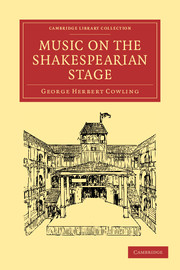Book contents
- Frontmatter
- PREFACE
- Contents
- LIST OF ILLUSTRATIONS
- Introduction
- CHAP. I Music in pre-Shakespearian drama
- CHAP. II An Elizabethan Stage and its music
- CHAP. III Musical instruments and their uses
- CHAP. IV Incidental music
- CHAP. V Musicians, Singers and Songs
- CHAP. VI Elizabethan music, and its share in the drama
- CHAP. VII Some literary allusions to music in Elizabethan plays
- Bibliography
- Appendix
- Index
CHAP. I - Music in pre-Shakespearian drama
Published online by Cambridge University Press: 07 September 2010
- Frontmatter
- PREFACE
- Contents
- LIST OF ILLUSTRATIONS
- Introduction
- CHAP. I Music in pre-Shakespearian drama
- CHAP. II An Elizabethan Stage and its music
- CHAP. III Musical instruments and their uses
- CHAP. IV Incidental music
- CHAP. V Musicians, Singers and Songs
- CHAP. VI Elizabethan music, and its share in the drama
- CHAP. VII Some literary allusions to music in Elizabethan plays
- Bibliography
- Appendix
- Index
Summary
English dramatic music took its beginnings from the antiphons and canticles of the medieval catholic church. The Mystery Plays—short dramas in popular verse dealing with scriptural incidents and legends of the saints—played by craft-gilds on certain festival days during the fifteenth and sixteenth centuries, drew quite naturally from the music of the church. Musicians played at times during their performance, and the plays contain antiphons, canticles, and a few lyrics—the earliest specimens of the English dramatic song.
It is impossible to give here a full list of references to music in the Mystery Plays; but we can get some notion of the share which music took by comparing the first play, The Creation, in existing series of gild-plays.
In the York play, a chorus of angels sings the canticles Te Deum laudamus, and Sanctus.
In the Chester play, The Creation and Fall, minstrels play whilst God puts Adam and Eve in Paradise. After they have eaten the fruit, this direction is found, “Then Adam and Eve shall cover ther members with leaves, hyddinge themselves under they treeyes; then God shall speake, and mynstrelles playinge.” This attempt to add mystery to God's words by the use of music shows that the producers were well aware of the value of music for enhancing emotional effect.
- Type
- Chapter
- Information
- Music on the Shakespearian Stage , pp. 7 - 21Publisher: Cambridge University PressPrint publication year: 2009First published in: 1913



